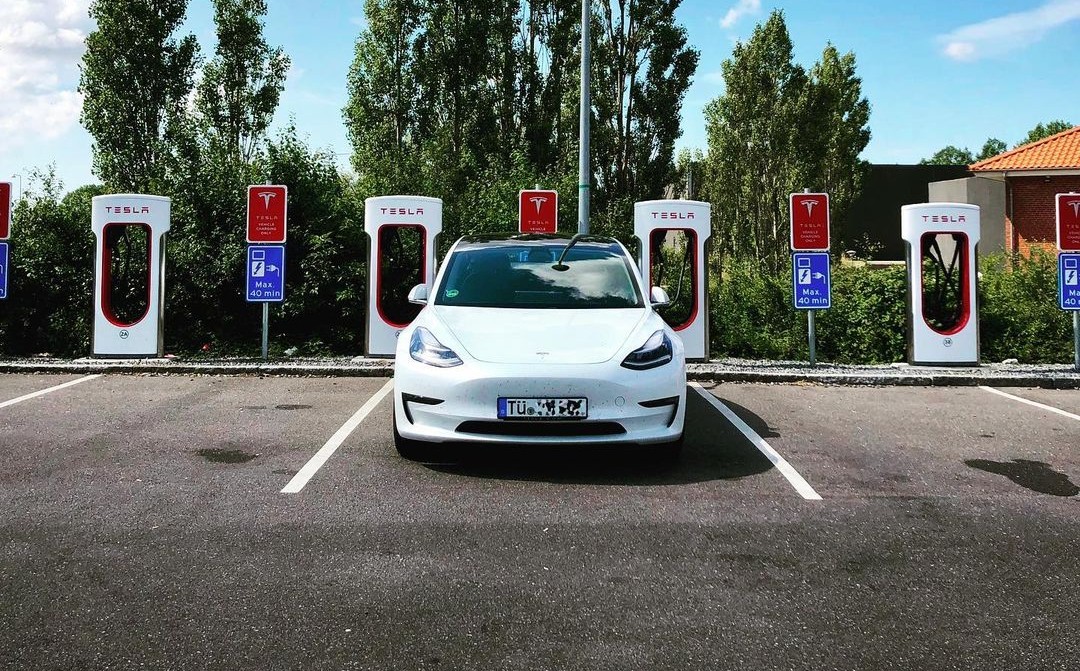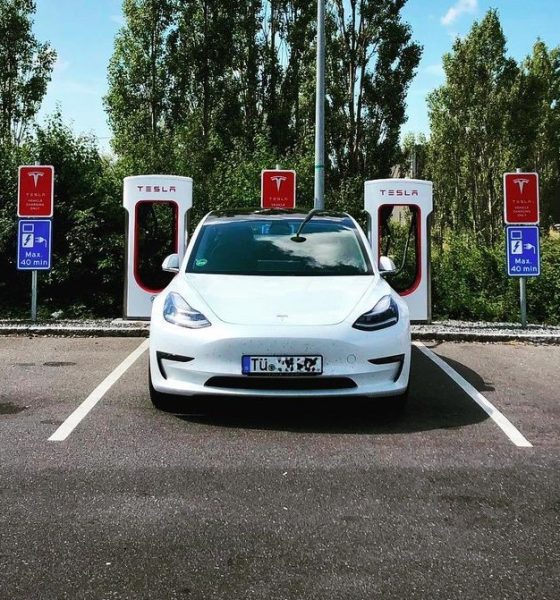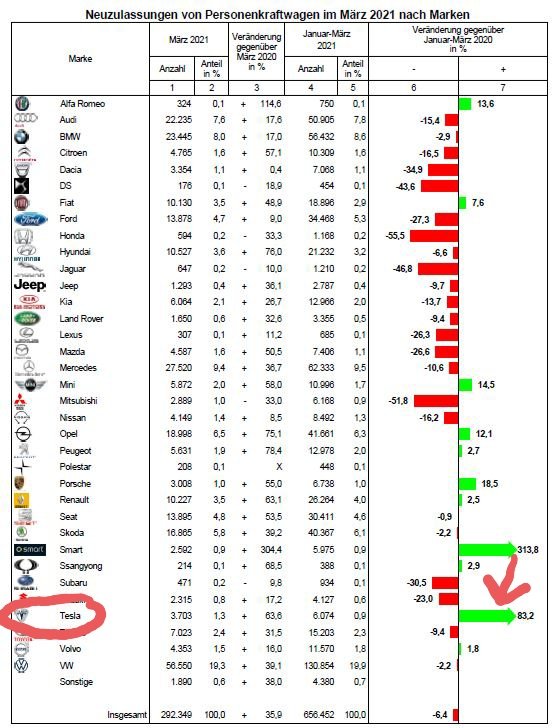

News
Tesla registrations skyrocket in Germany even though Giga Berlin hasn’t built a car yet
Tesla all-electric vehicles showed tremendous growth in terms of registrations in Germany, skyrocketing over 83% in Q1 2021 compared to the same period in 2020. Tesla continues to show exceptional expansion in Germany, despite its production facility within the country not building any vehicles yet.
In the past year, Tesla has expanded its international footprint greatly through the production of its all-electric vehicles in regions outside the United States. With no vehicles currently being produced in Europe by Tesla, the company is still showing the ability to grow in registrations, thanks to increasing demand and an exportation strategy of its vehicles from Shanghai to Europe. The decision to export vehicles from its Chinese production facility to the European market is paying dividends, as Tesla grew exceptionally in the first quarter of 2021.
New data from Germany’s Federal Motor Transport Authority (FMTA) shows that Tesla registered 3,703 units in March 2020, a strong finish to an explosive first quarter. The March registrations accounted for over 60% of the quarter’s registrations as a whole, where Tesla had 6,074 of its cars filed with the German FMTA.
Credit: Germany Kraftfahrt-Bundesamt| @M0scovium on Twitter
The real indication of growth, however, does not lie in the impressive figures that Tesla has shown in the first quarter of 2021 alone. It lies in the comparison of Q1 2021 to Q1 2020, where Tesla showed an 83.2% increase in registrations Year over Year. The growth is the second-highest on the list, trailing only SMART, which registered a 313.8% increase in vehicle registrations when comparing Q1 2021 to Q1 2020.
Tesla has managed to exhibit tremendous growth and demand increases while not building any vehicles in Germany domestically. The company will soon open the Giga Berlin production facility, a production unit that has been in development since late 2019 when Elon Musk announced the factory’s arrival while accepting an automotive industry award. Tesla has battled through various time delays thanks to the COVID-19 pandemic to remain on time with its project and plans to begin production and deliveries of the Model Y crossover later this year.
Earlier this week, Teslarati reported on growing EV registrations in the United Kingdom, which were displacing the sales of petrol and diesel-powered vehicles. The expansion of electric cars continues to be evident across the world, not only in the United States where Tesla holds its main market. Tesla has been able to provide an expansive footprint in the highly competitive Chinese and UK markets, as well as Europe where EVs charge toward the majority in terms of powertrains. Tesla’s German production facility is sure to only increase these vehicle registrations moving forward, as exports will not be needed to keep up with the ever-growing demand for the company’s cars.

News
Tesla FSD fleet is nearing 7 billion total miles, including 2.5 billion city miles
As can be seen on Tesla’s official FSD webpage, vehicles equipped with the system have now navigated over 6.99 billion miles.

Tesla’s Full Self-Driving (Supervised) fleet is closing in on almost 7 billion total miles driven, as per data posted by the company on its official FSD webpage.
These figures hint at the massive scale of data fueling Tesla’s rapid FSD improvements, which have been quite notable as of late.
FSD mileage milestones
As can be seen on Tesla’s official FSD webpage, vehicles equipped with the system have now navigated over 6.99 billion miles. Tesla owner and avid FSD tester Whole Mars Catalog also shared a screenshot indicating that from the nearly 7 billion miles traveled by the FSD fleet, more than 2.5 billion miles were driven inside cities.
City miles are particularly valuable for complex urban scenarios like unprotected turns, pedestrian interactions, and traffic lights. This is also the difference-maker for FSD, as only complex solutions, such as Waymo’s self-driving taxis, operate similarly on inner-city streets. And even then, incidents such as the San Francisco blackouts have proven challenging for sensor-rich vehicles like Waymos.
Tesla’s data edge
Tesla has a number of advantages in the autonomous vehicle sector, one of which is the size of its fleet and the number of vehicles training FSD on real-world roads. Tesla’s nearly 7 billion FSD miles then allow the company to roll out updates that make its vehicles behave like they are being driven by experienced drivers, even if they are operating on their own.
So notable are Tesla’s improvements to FSD that NVIDIA Director of Robotics Jim Fan, after experiencing FSD v14, noted that the system is the first AI that passes what he described as a “Physical Turing Test.”
“Despite knowing exactly how robot learning works, I still find it magical watching the steering wheel turn by itself. First it feels surreal, next it becomes routine. Then, like the smartphone, taking it away actively hurts. This is how humanity gets rewired and glued to god-like technologies,” Fan wrote in a post on X.
News
Tesla starts showing how FSD will change lives in Europe
Local officials tested the system on narrow country roads and were impressed by FSD’s smooth, human-like driving, with some calling the service a game-changer for everyday life in areas that are far from urban centers.

Tesla has launched Europe’s first public shuttle service using Full Self-Driving (Supervised) in the rural Eifelkreis Bitburg-Prüm region of Germany, demonstrating how the technology can restore independence and mobility for people who struggle with limited transport options.
Local officials tested the system on narrow country roads and were impressed by FSD’s smooth, human-like driving, with some calling the service a game-changer for everyday life in areas that are far from urban centers.
Officials see real impact on rural residents
Arzfeld Mayor Johannes Kuhl and District Administrator Andreas Kruppert personally tested the Tesla shuttle service. This allowed them to see just how well FSD navigated winding lanes and rural roads confidently. Kruppert said, “Autonomous driving sounds like science fiction to many, but we simply see here that it works totally well in rural regions too.” Kuhl, for his part, also noted that FSD “feels like a very experienced driver.”
The pilot complements the area’s “Citizen Bus” program, which provides on-demand rides for elderly residents who can no longer drive themselves. Tesla Europe shared a video of a demonstration of the service, highlighting how FSD gives people their freedom back, even in places where public transport is not as prevalent.
What the Ministry for Economic Affairs and Transport says
Rhineland-Palatinate’s Minister Daniela Schmitt supported the project, praising the collaboration that made this “first of its kind in Europe” possible. As per the ministry, the rural rollout for the service shows FSD’s potential beyond major cities, and it delivers tangible benefits like grocery runs, doctor visits, and social connections for isolated residents.
“Reliable and flexible mobility is especially vital in rural areas. With the launch of a shuttle service using self-driving vehicles (FSD supervised) by Tesla in the Eifelkreis Bitburg-Prüm, an innovative pilot project is now getting underway that complements local community bus services. It is the first project of its kind in Europe.
“The result is a real gain for rural mobility: greater accessibility, more flexibility and tangible benefits for everyday life. A strong signal for innovation, cooperation and future-oriented mobility beyond urban centers,” the ministry wrote in a LinkedIn post.
News
Tesla China quietly posts Robotaxi-related job listing
Tesla China is currently seeking a Low Voltage Electrical Engineer to work on circuit board design for the company’s autonomous vehicles.

Tesla has posted a new job listing in Shanghai explicitly tied to its Robotaxi program, fueling speculation that the company is preparing to launch its dedicated autonomous ride-hailing service in China.
As noted in the listing, Tesla China is currently seeking a Low Voltage Electrical Engineer to work on circuit board design for the company’s autonomous vehicles.
Robotaxi-specific role
The listing, which was shared on social media platform X by industry watcher @tslaming, suggested that Tesla China is looking to fill the role urgently. The job listing itself specifically mentions that the person hired for the role will be working on the Low Voltage Hardware team, which would design the circuit boards that would serve as the nervous system of the Robotaxi.
Key tasks for the role, as indicated in the job listing, include collaboration with PCB layout, firmware, mechanical, program management, and validation teams, among other responsibilities. The role is based in Shanghai.
China Robotaxi launch
China represents a massive potential market for robotaxis, with its dense urban centers and supportive policies in select cities. Tesla has limited permission to roll out FSD in the country, though despite this, its vehicles have been hailed as among the best in the market when it comes to autonomous features. So far, at least, it appears that China supports Tesla’s FSD and Robotaxi rollout.
This was hinted at in November, when Tesla brought the Cybercab to the 8th China International Import Expo (CIIE) in Shanghai, marking the first time that the autonomous two-seater was brought to the Asia-Pacific region. The vehicle, despite not having a release date in China, received a significant amount of interest among the event’s attendees.








